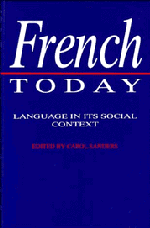Book contents
- Frontmatter
- Contents
- List of figures and maps
- List of tables
- Notes on the contributors
- Acknowledgements
- Introduction
- 1 French: a planned language?
- 2 Sociosituational variation
- 3 Regional variation in France
- 4 The other languages of France: towards a multilingual policy
- 5 The migrant languages of Paris
- 6 Gender and language in French
- 7 The reform of the writing system
- 8 Alternative French
- 9 New words for new technologies
- 10 Language and style in politics
- 11 French and French-based Creoles: the case of the French Caribbean
- 12 French in Africa
- 13 French in Canada
- 14 Sociolinguistic variation and the linguist
- Bibliography
- Index
2 - Sociosituational variation
Published online by Cambridge University Press: 05 June 2012
- Frontmatter
- Contents
- List of figures and maps
- List of tables
- Notes on the contributors
- Acknowledgements
- Introduction
- 1 French: a planned language?
- 2 Sociosituational variation
- 3 Regional variation in France
- 4 The other languages of France: towards a multilingual policy
- 5 The migrant languages of Paris
- 6 Gender and language in French
- 7 The reform of the writing system
- 8 Alternative French
- 9 New words for new technologies
- 10 Language and style in politics
- 11 French and French-based Creoles: the case of the French Caribbean
- 12 French in Africa
- 13 French in Canada
- 14 Sociolinguistic variation and the linguist
- Bibliography
- Index
Summary
Defining and describing sociosituational variation
Les théories linguistiques définissent toutes un objet réduit par rapport à l'usage qui est fait d'une langue; elles rejettent done hors du champ des faits que d'aucuns considèrent comme primordiaux; citons, en vrac, les aspects paraverbaux et non verbaux qui accompagnent la parole, la variation des usages (phonologique, morphologique, syntaxique, sémantique et pragmatique) en fonction de facteurs individuels, sociaux, situationnels. Cet élargissement de l'objet peut-il se faire dans le cadre des théories que l'on peut considérer aujourd'hui comme classiques, du fonctionnalisme par exemple? Nombreux sont ceux qui essaient de créer, d'aménager de nouveaux modèles descriptifs au sein de la théorie; d'autres, en développant et modifiant certaines définitions, comme celle de la communication, vont accroître le champ; d'autres enfin vont modifier la théorie afin de la rendre plus adéquate, de leur point de vue, à l'objet.
(Lefebvre and Morsley 1990)A major difference between English and French is the way in which spoken French has come to diverge from written French. Related to this - though not identical with it - is the distinction between ‘informal’ and ‘formal’ usage, which is much greater in French than it is in British English. Although for many years the majority of descriptive and reference works failed to take account of either ‘oral’ or ‘informal’ language use, except to censure it as a deviation from the ‘standard’, there has for the last few decades been a recognition by some that register (i.e. sociosituational variation, or variation dependent on setting and relationship between interlocutors) is an important phenomenon in French.
- Type
- Chapter
- Information
- French TodayLanguage in its Social Context, pp. 27 - 54Publisher: Cambridge University PressPrint publication year: 1993
- 6
- Cited by



